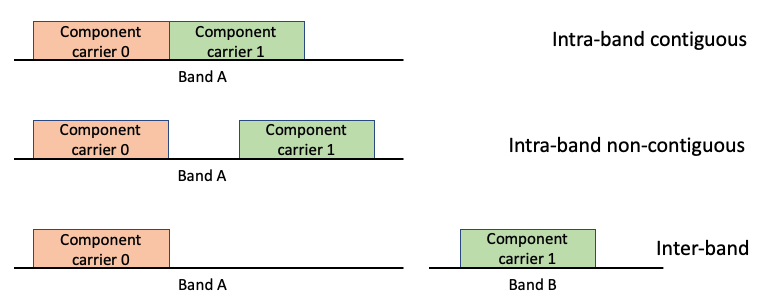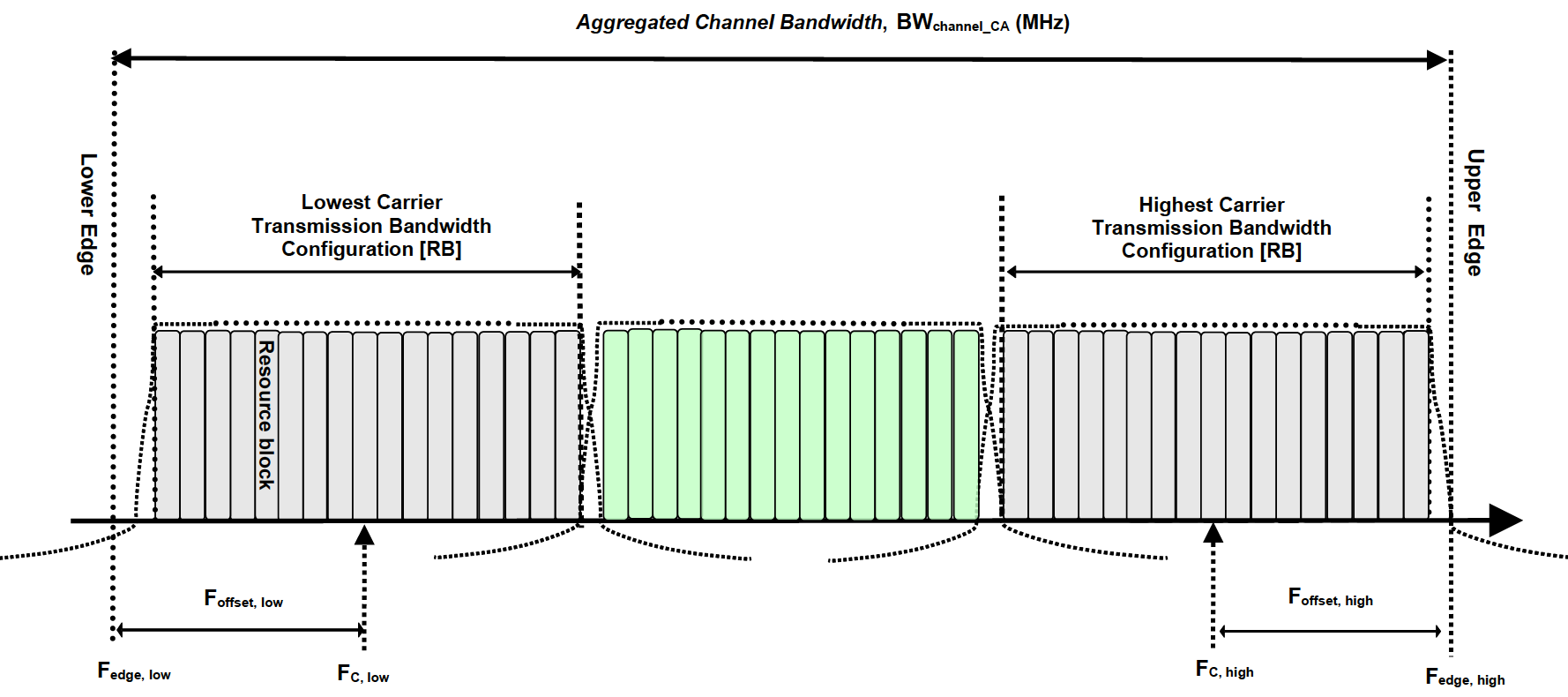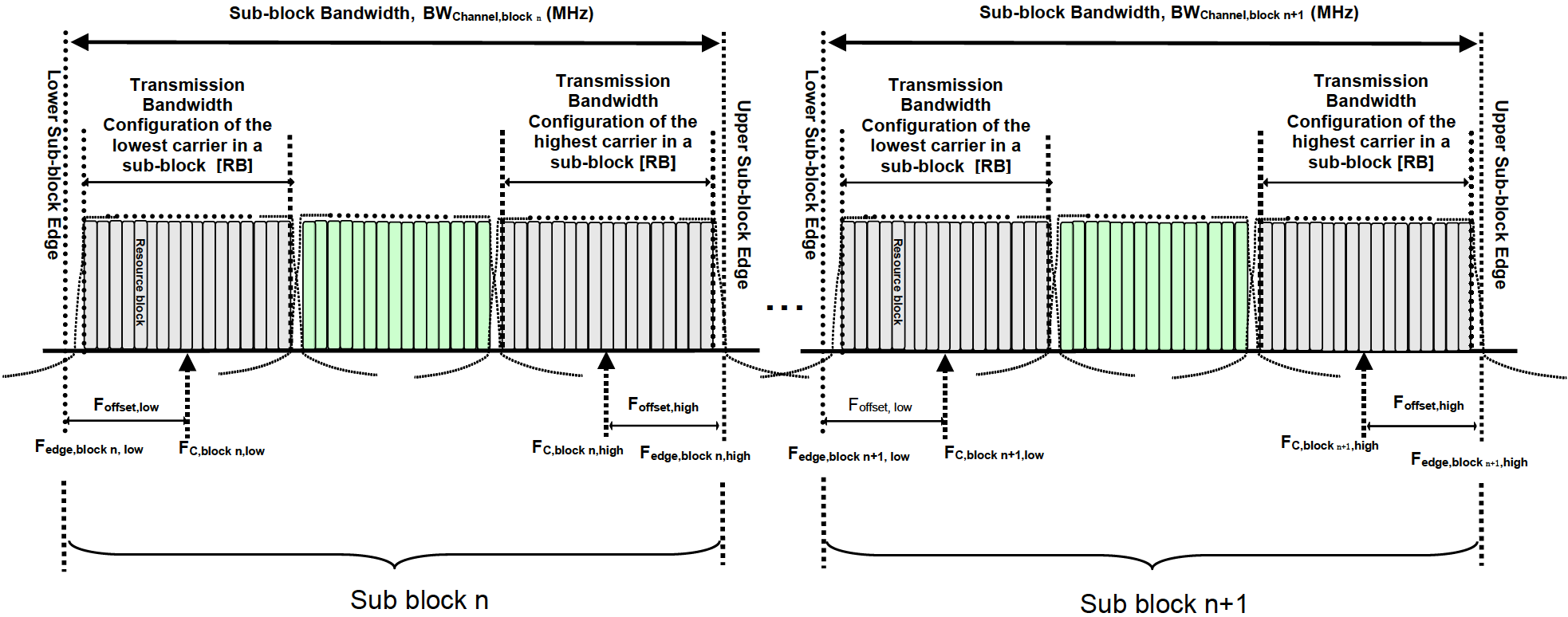Carrier Aggregation is used in wireless communication to increase the data rate per user, whereby multiple frequency blocks (component carriers) are assigned to the same user. The maximum possible data rate per user is increased the more frequency blocks are assigned to a user. The sum data rate of a cell is increased as well because of a better resource utilization. In addition, load balancing is possible with carrier aggregation.
Types of Carrier Aggregation:
- Intra-band contiguous CA: the spectrum of the component carriers are contiguous.
- Intra-band non-contiguous CA: the component carriers are in the same band, but are separated by a gap.
- Inter-band CA: the component carriers are in different bands.

For carrier aggregation, the maximum transmission bandwidth configuration is defined per component carrier as in "NR bandwidth".
Intra-band contiguous carrier aggregation
For intra-band contiguous carrier aggregation, Aggregated Channel Bandwidth and Guard Bands are defined as follows, see Figure 5.3A.3-1.
 Figure 5.3A.3-1: Definition of Aggregated Channel Bandwidth for intra-band carrier aggregation
Figure 5.3A.3-1: Definition of Aggregated Channel Bandwidth for intra-band carrier aggregationThe aggregated channel bandwidth, , is defined as
The lower bandwidth edge and the upper bandwidth edge of the aggregated channel bandwidth are used as frequency reference points for transmitter and receiver requirements and are defined by
The lower and upper frequency offsets depend on the transmission bandwidth configurations of the lowest and highest assigned edge component carrier and are defined as
NRB,low and NRB,high are the transmission bandwidth configurations according to Table 5.3.2-1 for the lowest and highest assigned component carrier; SCSlow and SCShigh are the sub-carrier spacing for the lowest and highest assigned component carrier respectively. SCSlow, SCShigh, NRB,low, NRB,high, and BWGB,Channel(k) use the largest μ value among the subcarrier spacing configurations supported in the operating band for both of the channel bandwidths according to Table 5.3.5-1 and BWGB,Channel(k) is the minimum guard band for carrier k according to Table 5.3.3-1 for the said μ value.
What it means:
- the low edge of the aggregated bandwidth equals the center frequency of the lower component carrier minus half of its transport bandwidth and the guard band.
- the high edge of the aggregated bandwidth equals the center frequency of the higher component carrier minus half of its transport bandwidth and the guard band.
Intra-band non-contiguous carrier aggregation
For intra-band non-contiguous carrier aggregation Sub-block Bandwidth and Sub-block edges are defined as follows, see Figure 5.3A.3-2.
 Figure 5.3A.3-2: Definition of sub-block bandwidth for intra-band non-contiguous spectrum
Figure 5.3A.3-2: Definition of sub-block bandwidth for intra-band non-contiguous spectrumThe lower sub-block edge of the Sub-block Bandwidth () is defined as
The upper sub-block edge of the Sub-block Bandwidth is defined as
The Sub-block Bandwidth, , is defined as follows:
The lower and upper frequency offsets and depend on the transmission bandwidth configurations of the lowest and highest assigned edge component carriers within a sub-block and are defined as
where and are the transmission bandwidth configurations according to Table 5.3.2-1 for the lowest and highest assigned component carrier within a sub-block, respectively. and are the sub-carrier spacing for the lowest and highest assigned component carrier within a sub-block, respectively. SCSlow, SCShigh, NRB,low, NRB,high, and BWGB,Channel(k) use the largest μ value among the subcarrier spacing configurations supported in the operating band for both of the channel bandwidths according to Table 5.3.5-1 and BWGB,Channel(k) is the minimum guard band for carrier k according to Table 5.3.3-1 for the said μ value.
The sub-block gap size between two consecutive sub-blocks is defined as
What it means: treat each sub-block of contiguous component carriers same as contiguous carrier aggregation.
UE channel bandwidth per operating band for CA
- For intra-band contiguous carrier aggregation, a carrier aggregation configuration is a single operating band supporting a carrier aggregation bandwidth class with associated bandwidth combination sets. For each carrier aggregation configuration, requirements are specified for all aggregated channel bandwidths contained in a bandwidth combination set, a UE can indicate support of several bandwidth combination sets per carrier aggregation configuration.
- For intra-band non-contiguous carrier aggregation, a carrier aggregation configuration is a single operating band supporting two or more sub-blocks, each supporting a carrier aggregation bandwidth class.
- For inter-band carrier aggregation, a carrier aggregation configuration is a combination of operating bands, each supporting a carrier aggregation bandwidth class.
| NR CA bandwidth class | Aggregated channel bandwidth | Number of contiguous CC | Fallback group |
|---|---|---|---|
| A | 1 | 1, 2, 3 | |
| B | 2 | 2, 3 | |
| C | 2 | 1, 3 | |
| D | 3 | 1, 3 | |
| E | 4 | 1, 3 | |
| G | 3 | 2 | |
| H | 4 | 2 | |
| I | 5 | 2 | |
| J | 6 | 2 | |
| K | 7 | 2 | |
| L | 8 | 2 | |
| M | 3 | 3 | |
| N | 4 | 3 | |
| O | 5 | 3 | |
NOTE 1: is maximum channel bandwidth supported among all bands in a release NOTE 2: It is mandatory for a UE to be able to fallback to lower order NR CA bandwidth class configuration within a fallback group. It is not mandatory for a UE to be able to fallback to lower order NR CA bandwidth class configuration that belong to a different fallback group NOTE 3 (for M, N, O): This bandwidth class is only applicable to bands identified for use with shared spectrum channel access in Table 5.2-1. | |||
Table 5.3A.4-1: CA bandwidth classes, FR2
| NR CA bandwidth class | Aggregated channel bandwidth | Number of contiguous CC | Fallback group |
|---|---|---|---|
| A | 1 | 1, 2, 3, 4 | |
| B | 2 | 1 | |
| C | 3 | 1 | |
| D | 2 | 2 | |
| E | 3 | 2 | |
| F | 4 | 2 | |
| G | 2 | 3 | |
| H | 3 | 3 | |
| I | 4 | 3 | |
| J | 5 | 3 | |
| K | 6 | 3 | |
| L | 7 | 3 | |
| M | 8 | 3 | |
| O | 2 | 4 | |
| P | 3 | 4 | |
| Q | 4 | 4 | |
NOTE 1: Maximum supported component carrier bandwidths for fallback groups 1, 2, 3 and 4 are 400 MHz, 200 MHz, 100 MHz and 100 MHz respectively except for CA bandwidth class A. NOTE 2: It is mandatory for a UE to be able to fallback to lower order CA bandwidth class configuration within a fallback group. It is not mandatory for a UE to be able to fallback to lower order CA bandwidth class configuration that belong to a different fallback group. | |||